Maritime Links Between China, Sumatra, the Malay Peninsula, and Buddhist Monasteries in India (c. 11th–12th Centuries) in the Light of Two Fragmentary Inscribed Strips of Copper from Muara Jambi
Abstract
1. Introduction
2. Description of the Artifacts
2.1. Strip Kept at BPK V Jambi
2.2. Strip Kept at Yayasan Rumah Menapo, Jambi
… nmu ga sakṣa da mcu oṁ ra …
… ddhan m kara (ṅa) la …
3. Text and Provisional Translation
| A | B |
 |  |
| Ar1. + kathora kāṅśa kaṇḍa 1 | barisi valānda … Ar2. ndenan· barkna pamūja ka bharāla śrībā... | Br1. …(lā)nda tāsak· damcu khaṇḍa 5 brātña kā 5 su 1 Br2. … (śrī)bālādityabihāra | dṅan· ka bharāla |
 |  |
| Av1. …lendracūḍāmaṇivarmmabihāra … | Bv1. … (bi)hāra + |
valānda—[valā]nda
śrī-bā[lāditya]—śrī-bālāditya
bihāra—(bi)hāra
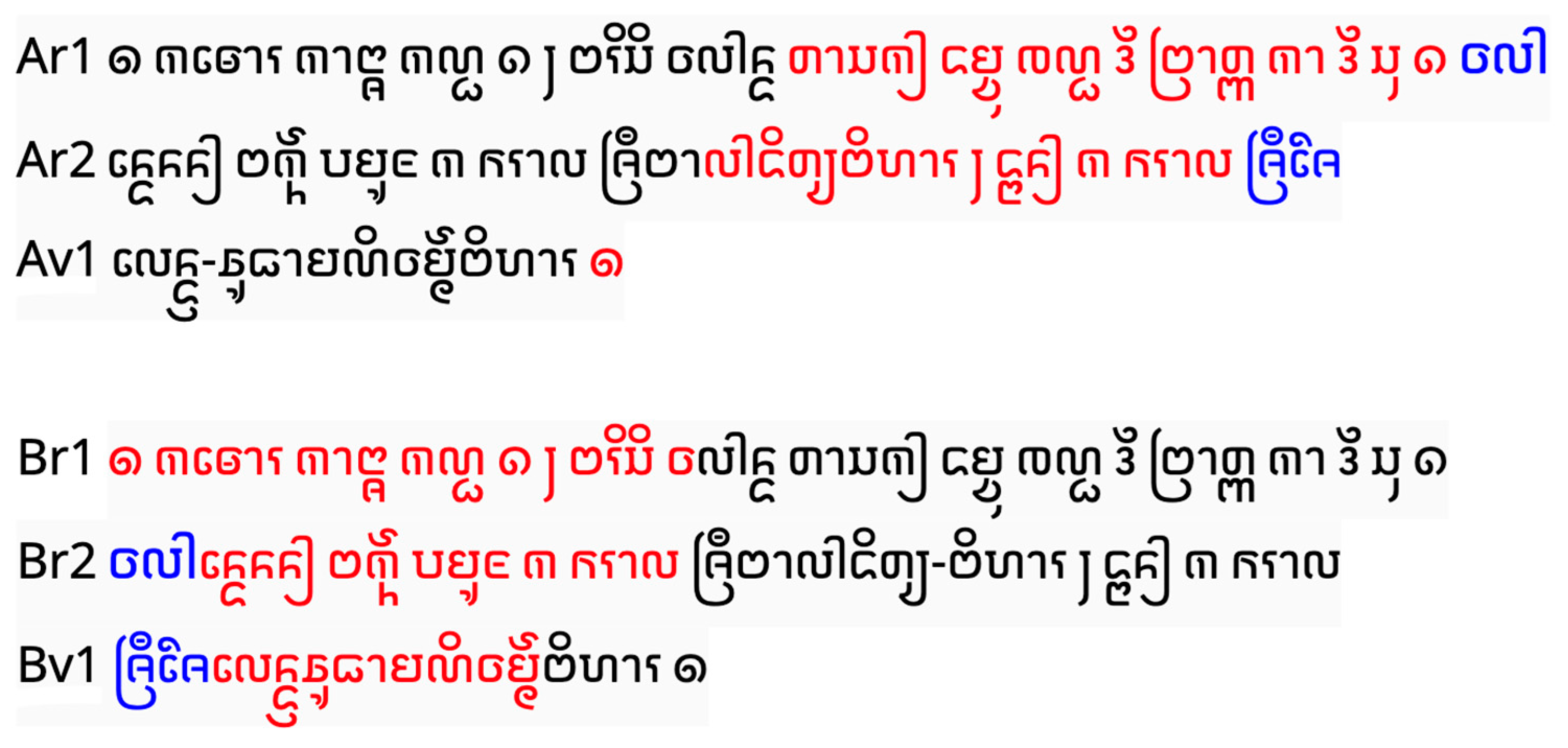
Reconstructionkathora kāṅśa kaṇḍa 1 | barisi valānda tāsak· damcu khaṇḍa 5 brātña kā 5 su 1 [valā]ndenan· barkna pamūja ka bharāla śrī-bālāditya-bihāra | dṅan· ka bharāla [śrī-śai]lendra-cūḍāmaṇivarmma-bihāra.
Provisional Translation1 kathora of kaṅśa, filled with 5 valanda tāsak damcu, weighing 5 kāṭi, 1 suvarṇa. These valanda are for worship to the Lord of the Śrī-Bālāditya monastery and to the Lord of the Śrī-Śailendra-Cūḍāmaṇivarman monastery.
4. Linguistic and Philological Commentary
5. Final Translation and Comparisons
1 bronze cauldron (kathora), filled with 5 bags (valānda) stuffed with cinnabar (damcu), weighing 5 kāṭi, 1 suvarṇa (i.e., about 3838 g). These bags are for worship to the Lord of the Śrī-Bālāditya monastery and to the Lord of the Śrī-Śailendra-Cūḍāmaṇivarman monastery.
- (1)
- ⚬ svasti śaka-varṣātīta 961 caitra-māsa, tithi tritiya sukla, śukra-vāra, tatkāla juru pā⌈-
- (2)
- ṇḍai suryya barbvat· bhaṭāra lokanātha ⚬ Imāni kuśala-mulāṇi sarbvasatva-sādharāṇaṁ k-
- (3)
- tvā Anuttarāyāṁ samyaksambodhau parināmayami (⚬)
- (1)
- ○ bhaṭāra kakīṅ abhaya brat· dhā 11 (2) bratniṁ mās ya su 1 mā 15The deity (bhaṭāra) at Abhaya: weight 11 dhāraṇas [in silver]. The weight of the gold, it is 1 suvarṇa, 15 māṣas.
- (1)
- //○// gavayan· bhaṭāra I ḍi(hya)[ṁ dyun pirak· brat· k]ā 4 rambutnya lpas· //○//Work belonging to the deity (bhaṭāra) of Dieng: silver vase weighing 4 kāṭi. Its hairs are loose.
6. The Inscribed Text in the Context of Transregional Buddhist Networks (c. 11th–12th Centuries)
the Bālādityavihāra was evidently the more important of the two establishments, for Buddhappiya made special mention of it while he left the identity of the other to be explained by his exegetist. Like the Cūḍāmaṇivarma Vihāra and Dhammāsoka Vihāra of Negapatam, Bālādicca Vihāra, too, appears to have been named after an important personage. The most famous Bālāditya of Buddhist history was the king of Magadha who, according to Hieun Tsiang [i.e., Xuanzang], was the founder of the celebrated vihāra of Nalanda but we cannot assert that a monastic establishment in the Coḷa country was named after him.
7. Conclusions
Author Contributions
Funding
Institutional Review Board Statement
Informed Consent Statement
Data Availability Statement
Acknowledgments
Conflicts of Interest
Abbreviations
| BPK | Balai Pelestarian Kebudayaan |
| CM | Classical Malay |
| MM | Modern Malay |
| OJ | Old Javanese |
| OM | Old Malay |
| V&AM | Victoria and Albert Museum |
| 1 | |
| 2 | See, for instance, the remark by Griffiths (2011, p. 139): “Compared to the wealth of epigraphical material using Indic systems of writing that has been preserved from Java, Bali or from other parts of Southeast Asia, the epigraphical record of the great island of Sumatra is very limited indeed”. For editions, translations, and discussions of short inscriptions from the Muara Jambi temple complex, see Griffiths (2011, pp. 159–65; 2012, pp. 201–7). There is also a wealth of inscribed amulets (Tejowasono et al. 2019; Meyanti and Andhifani 2021). However, none of the published items from Muara Jambi (which can be easily found via idenk.net, accessed on 13 May 2025) contain any historical information of the type that we will discuss in this article. |
| 3 | This was formerly the Balai Pelestarian Cagar Budaya (Cultural Heritage Conservation Bureau) in charge of the four provinces of Jambi, Sumatera Selatan, Bengkulu, and Kepulauan Bangka Belitung (https://kebudayaan.kemdikbud.go.id/bpcbjambi/tentang-kami-balai-pelestarian-cagar-budaya-jambi, accessed on 13 May 2025). At the time of our field research, it had become the Balai Pelestarian Kebudayaan with a smaller coverage area numbered “V”. At the time of this writing, the webpage for BPK V is not working and the creation of a separate Ministry of Culture presages further changes in the organization of heritage conservation agencies. |
| 4 | Formerly Yayasan Padmasana, an NGO devoted to the preservation, study, and dissemination of the (pre-Islamic) heritage of Muara Jambi. |
| 5 | The aforementioned publication paraphrases the information contained in the 2019 catalogue, adding a new transliteration attributed to Wahyu Rizki Andhifani and Hedwi Prihatmoko, but including no translation, palaeographic and linguistic commentary, or discussion of the historical context and implications of the inscription, which we offer here for the first time. |
| 6 | Examination with an optical microscope was not possible. We used a handheld jeweler’s magnifying glass (10× magnification, 21 mm viewing field, triplet lens). It was also not possible to bring the two artefacts together for direct comparison. |
| 7 | Although it has not been possible to carry out an analysis of the metal, the aforementioned catalogue classifies the strip as a copper inscription (Cu). The orange–red color we observed in areas that are not covered with oxidation—characteristic of fairly pure copper (in contrast with the yellow–brown color of brass for example)—tends to confirm this assessment. Comparison with artefact B, of a similar color and the main metal of which is copper according to XRF analysis (see note 10 below), makes this possibility even more likely. Besides our two inscription fragments, only one example of an artefact not manufactured in tin is given in the catalogue by Tejowasono et al. (2019, p. 16), namely “013, 04/BPCBJB/Cu/VIII/2019”, a fragmentary and as yet undeciphered inscription consisting of a few characters on the two sides of a broken plate of irregular shape measuring 3.8 × 3.4 cm. |
| 8 | We did not have a tool, such as a caliper, to measure the thickness of both strips. |
| 9 | While inscribed silver and gold foils were commonly rolled up to be inserted inside bronze statues as part of consecration deposits (see Mechling et al. 2018, p. 99–101, figs. 46–47), the copper strips under discussion had a different function, as we will explain below. In Sumatra, it seems common practice to cut inscribed strips in half to multiply the number of artefacts that can be sold after their discovery. |
| 10 | The catalogue reports that the artifact’s copper content is 88.79%. However, screenshots of the two XRF scans carried out on two sampling spots of the artifact by the research team in charge of the compilation of the catalogue on 18/06/2019, which were kindly made available by Wahyu Rizki Andhifani, indicate readings of, respectively, 96.59% and 96.20% Cu, with a margin of error of +/− 0.05%. The other values of the two readings are as follows: for reading one, 1.53% Si, 1.07% Al, 0.670% S, 0.072% Fe, 0.048% P, and 0.021% Pb; and for reading two, 1.68% Si, 1.03% Al, 0.774% S, 0.21% Fe, 0.081 P, and 0.025% Pb. |
| 11 | On sandhi in Old Malay, see Clavé and Griffiths (2022, p. 181). |
| 12 | Cf. Mahdi (2015, pp. 194–95) on ta- = ter- in the Tanjung Tanah ms., with examples like taamit and taulih from the Tanjung Tanah ms. While these examples explicitly show hiatus after the prefix, we need to assume that tāsak represents a pronunciation without hiatus or conceals the hiatus in favor of Sanskrit spelling norms. By way of comparison, we may point out that, in the closely related Old Javanese writing tradition, it is very common for spelled vowels ā to represent what was probably pronounced as a /aʔa/ with hiatus (e.g., kamatān = ka-mata-an ‘seen’), although this spelling tendency tends to become less pronounced over the course of the centuries and is not clearly represented in Zoetmulder (1982). |
| 13 | |
| 14 | It may be helpful to recall that bronze is a copper alloy with a low tin content; bell metal is a copper alloy with a higher tin content; and brass is an alloy of copper with zinc. |
| 15 | Vincent (2012, p. 167): “Dans le cas des inscriptions sanskrites du Cambodge, kaṁsa qualifie donc plus spécifiquement le bronze, ce que confirme le plus souvent le contexte dans lequel est employé ce terme.” |
| 16 | See Turner (1962–1966), entries 2648 *kaṭṭōra “cup” and 2651 káṭhōra “hard, solid, stiff”. There is some indication in Sanskrit lexicographic texts that the latter word could also cover other meanings, e.g., Hemacandra’s Anekārthasaṅgraha (ed. Hoshing 1929) 3.570cd kaṭhorau pūrṇakaṭhinau indicated that it could mean both “full” and “hard”. |
| 17 | Stela from Prasat Preah Nan (K. 89), https://dharmalekha.info/texts/DHARMA_INSCIK00089 (accessed on 13 May 2025), lines 4–7: bhūmi man jauv nu padigaḥ jyaṅ 5 bhājana jyaṅ 5 mvāy śata vroḥh prāk 6 nu duk liṅgaśodhana bhājana nu dut mvāy, prāk nu duk kruc mārgga I svok I kathor I, neḥ kalpanā āy kamrateṅ añ liṅgapura “Land which he bought with [one] spittoon of 5 jyaṅ; one platter of 5 jyaṅ; 100 vroḥ, 6 (unspecified units of) silver to be devoted to the liṅga purification; one platter to be devoted to [it]; 1 (unspecified unit of) silver to be devoted to kruc mārgga; 1 plateau; 1 kathora. These are the offerings to My High Lord of Liṅgapura”. No more can be learned from a single other occurrence in Khmer epigraphy (K 470). |
| 18 | Ed. Pigeaud (1924, p. 105, lines 12–13): kapālaniṅ vvaṅ pinakatahapanira, lavan kaṇṭora lima kvehnya, ya ta makavaḍahnirāṅayəm śavaniṅ vvaṅ. This was translated by Stuart Robson (in Robson and Sidomulyo 2021, p. 47) “The skull of people they used as drinking cup, and bowls five in number, these served as their containers for keeping the corpses cool and damp.” A passage resuming essentially the same words figures a few lines further down in Pigeaud’s edition. |
| 19 | Furui (2016, p. 669): “The donated movables listed in the grant include vessels and utensils (brass cooking vessels, brass/copper water jars, three vessels for bali, kalantakas, brass taṣṭhakas, small cups), furniture (ivory stools), palanquins, musical instruments (brass trumpets), parasols and instruments of labour (whetstones, adzes, spades, axes, gleaning baskets, digging instruments, saws, daggers) (ll. 43–46). The utensils, furniture and palanquins seem to be meant for Ājīvika ascetics, while brass trumpets may be used for the religious practice of song and dance. Instruments of labour, on the other hand, suggest their use in productive labour and household duties by some service groups, although their assignment to the use by ascetics cannot be ruled out.” |
| 20 | Such is the argument in Zhang et al. (2024), though the wholesale price of export ceramics abroad does not factor into their estimations. |
| 21 | We have since learned that the same idea had already been formulated a few years prior to Postma, with reference to the Old Javanese equivalent of valānda, by Balinese scholars I Gusti Putu Ekawana and I Made Jaya, as cited below in our note on Balinese scholarship (note 29). |
| 22 | Gonda (1973, pp. 31–32): “There are also some traces of Singhalese influence. The Malay word bĕlanja ‘outlay, expenditure’ and in polite speech ‘salary’ (regarded as a reimbursement and not as a wage), also euphemistically for ‘a gift’, in modern Indonesia, besides ‘housekeeping money’ also ‘(public) expenditure’ has long been regarded as the only unaltered Pāli word: valañja which not only means ‘trace,’ or ‘use, design’, but also ‘that which is spent or secreted’ i.e., ‘outflow, excrement (in sarīravalañja ‘faeces’). The verb valañjeti, at the root of which [the compilers of the Pali Dictionary used by Gonda] have supposed a Singhalese word, can also express the idea of ‘spending’. This word, which in Indonesia no doubt always belonged to the ‘economical’ sphere, seems to have been a commercial loan rather than a direct borrowing from Pāli texts, the more so as it seems to be wanting in Old-Javanese (in Balinese where it is also used as a root for ‘going shopping’ it may be considered as a Javanese or Malay loan).” Before Gonda, we find the idea of a connection with Pali valañja already in the second edition of Gericke and Roorda’s dictionary of Javanese, revised and enlarged by Vreede and Gunning (Gericke and Roorda 1901), under the entry “blănja: of bêlănja, (Pâli walañja, uitgaven PK.)” where “PK” stands for a personal communication received by the authors from Professor (Hendrik) Kern. |
| 23 | Because Pali is a Middle Indo-Aryan language while Sinhalese is a New Indo-Aryan one, and the former has status as a language of scripture while the latter does not, both historical linguistic and cultural attitudes with regard to these languages tend to predispose scholars to the assumption of Pali priority. Nevertheless, under the entry for the verb form valañjeti that exists beside the noun valañja, Rhys Davids and Stede (1925, p. 603) argued for the opposite relationship in this case: “But the root & its derivations are only found in lexicographical and grammatical works, therefore it is doubtful whether it is genuine. [...] There seems to be a Singhalese word at the root of it, as it is certainly dialectical.” |
| 24 | Clough (1892, p. 575): “වලඳ, Walaṉda, s. sign, mark, spot, token; pot, pan, earthen cooking vessel: pl. වලන් valan. Walaṉdanavá, වලඳනවා, v. to eat, used only of priests or men of rank; also, to enjoy”. For the phonological history of the “half nasal” transliterated as and on the declension of inanimate nouns in Sinhalese, see Geiger (1938, sct. 23.1d, 64.2, 107.1, 108.1). |
| 25 | It seems likely that the Tamil word வளந்து vaḷantu, meaning “Big pot or vessel” and recorded only for the Jaffna dialect, is a loanword from Sinhalese. |
| 26 | –Sumanasāntaka 142.14, edition and translation by Worsley et al. (2013):
–Bhomāntaka 3.19, edition and translation Teeuw and Robson (2005):
Many were the servant girls who stretched out their arms to offer the prince their love: The tip of their passion was of course to be found in their bodies, naturally wrapped in their beauty. Others languished in painful heartache, picturing the pleasure of being the vessel of his yearning. The awe and sweetness of their joyful glances were the box for storing it, set with jewels like “eyes”. |
| 27 | |
| 28 | The inscriptions with valanda/valaṇḍa are Kayubihi (no. 446, 999 Śaka/1077 CE, 2v4 and 3r5); Depeha/Bet Ngandang A (no. 555, mid-12th century CE, 3v2, 3r5, 3v2 and 4r2); and Kintamani F (no. 704, 1122 Śaka/1200 CE, 4r4–5, 4v2, 4r4–5, 5r2). Those with valantən are Dawan (no. 404a, 975 Śaka/1053 CE, 4r2–3, 5v3); Serai AIII (410, 989 Śaka/1067 CE, 6r4, 6v1, 6v2); Pandak Badung (no. 436, 993 Śaka/1071 CE, 3r2); Bila II (no. 441, 995 Śaka/1072 Śaka, 5r4); Museum Mpu Tantular A (no. 509, 12th c. CE, 3v6); and Lukluk + Ubung B + Pamecutan B (no. 560, 12th c. CE, 4v2). |
| 29 | Unfortunately, none of the occurrences fall in the timeframe covered by Goris (1954) so that no form of the word valanda figures in his glossary. In a note to their translation of the Kayubihi inscription, Ekawana and Jaya (1987, p. 42) suggested that valanda can express the meaning of belanja in Indonesian (i.e., in C/MM), but it has nothing to do with belanda, contrary to the assumption previously expressed by Poeger (1964, p. 12). The relevant passage is 2v3–4 (ed. and translation by Ekawana and Jaya, with some corrections on the reading): pacakṣu ku 1 kabehananya, riṁ pirak· lumari valanda, tahilakna I jro paryyaṅan· riṁ cetra śukla tithī saptamī “pacakṣu besarnya 1 kupaṅ, terhadap perak murni (asli) walanda supaya dibayarkan (disetor) di dalam parhyaṅan (bangunan suci) pada bulan Cetra, paro terang, tanggal 7 [the amount of] pacakṣu is 1 kupaṅ, against pure silver let a valanda be paid to the parhyaṅan (religious establishment) in the month of Cetra, on the seventh day of the waxing fortnight”. Translations of the Dawan and Pandak Bandung inscriptions are available by Santosa (1965) and Ardika and Beratha (1998). In his translation of Dawan and Pandak Bandung, Ida Bagus Santosa did not translate the word valantən (pp. 62, 92). I Ardika and Beratha offered different translations of valantən from one inscription to the other. In the Dawan inscription, they translated it as “tradition” (pp. 144–45), but in the Pandak Bandung inscription, they translated it as “offering” (pp. 315–16). It is possible that they believed the word valantən to have the same meaning as bantən. Anyhow, they provided no justification for either one of their translations. These are the relevant passages with Ardika and Beratha’s translations: –Dawan 4r2–3 amnera riṅ pirak lumaku valantən
–Pandak Bandung 3r2–3 tan panusuna riṅ pirak lumaku valantən
|
| 30 | On the weight units, see the references furnished below in our entry brat. |
| 31 | For the record, we mention here that some OJ inscriptions also use the derived noun pavalanda that seems to denote a tax or levy related to valanda. The relevant passages do not seem to help in determining the meaning of the base word. |
| 32 | Wilkinson (1959) indicates certain words as “courtly” synonyms of others and mentions such pairs as antan (alu), bangsal (balai), angan (hati), intan (hira), jantan (jalu), jintan (jahe), kacang (kara), negeri (negara), and santan (sari). Several of these pairs may involve borrowing from Javanese. As potential additions to Wilkinson’s examples, we would like to mention kencing (kemih) as well as kantung (and Javanese kanthong, both presumably related to kaṇḍi ‘pouch’ in OJ). Alas, we have not found any example, in Malay or Javanese, of the derivation of a krama form by changing /d/ to /j/. |
| 33 | We are aware of a 14th-century OJ inscription using rujira instead of expected rudira (from Sanskrit rudhira), and Sanskrit doli has become joli in OJ. |
| 34 | The term 銅子 is not prevalent in early Chinese sources. In contrast, we find dozens of occurrences of the term 銅錢 (Mandarin tongqian, Hokkien tangchiⁿ) where it definitely means “copper coin” in Song sources alone. The oldest use of 銅子 in the dictionaries we examined was in three literary works dating to the first half of the 20th century. We use Hokkien to determine the pronunciation of these terms based on the historical prevalence of southern Fujianese people in Southeast Asia beginning around the time of the Song dynasty. Middle Chinese would serve as a useful comparison for reconstructing most other Chinese languages at this time, though Fujian languages would be an exception as they evolved from Old Chinese. See Pulleyblank (1984, p. 3). |
| 35 | See https://sutian.moe.edu.tw/zh-hant/tshiau/?lui=tai_su&tsha=%E4%B8%B9 (accessed on 13 May 2025) for modern Hokkien pronunciations of the first character. The onset of 丹 in these recordings sounds like /t/ in Malay, but it is quite possible that a dialect with a sound more like Malay /d/ was the source (https://en.wiktionary.org/wiki/丹, accessed on 13 May 2025). Regarding the second character, recordings of its modern Hokkien pronunciation are available at https://sutian.moe.edu.tw/zh-hant/tshiau/?lui=tai_su&tsha=%E6%9C%B1 (accessed on 13 May 2025). |
| 36 | Although deposits are now known to exist in Japan, and it is also recorded as an exporter of mercury, Japan was importing cinnabar at the time that our inscribed artifacts were produced. It is not clear when deposits in central Sumatra were first discovered, though it is believed that the mineral was being mined in western Jambi at some point prior to European occupation (Miksic 1985, p. 69, citation no. 1). The Xin Tang shu does state that Śrīvijaya was a source of gold, cinnabar, and ambergris (Xin Tang shu, juan 222, Shilifoshi section, ed. Ouyang 1936). Although Śrīvijaya’s reputation as a source of gold was widely known, ambergris was a commodity brought to China from East Africa and West Asia, so it is not clear in this passage if cinnabar was transshipped to China from Śrīvijaya or if it was mined there. |
| 37 | It should be noted that this refers to goods brought to Japan by Chinese merchants, as some of the items on the list originated from Southeast Asia and Korea. |
| 38 | Inventory no. IPN.2639. See https://collections.vam.ac.uk/item/O24788/standing-buddha-sculpture-unknown/ (accessed on 13 May 2025) and Guy (2000, p. 107, fig. 6). While no scientific analysis has been carried out on this statue, to our knowledge, gilding through mercury amalgam has been scientifically demonstrated for Buddhist copper–alloy statues from several regions through surface analyses. One of them is from South India, possibly from the same tradition or even the same workshop as the V&AM statue (Gänsicke 2016, p. 17, fig. 2, ca. 9th century). Other examples come from Java (Fontein 1990, p. 183, no. 38, ca. 8th–9th century), Cambodia (Bourgarit et al. 2003, pp. 115–16, Table 5, ca. 7th–9th century and 12th–early 13th century; Gerschheimer and Vincent 2010, pp. 117–18), Central Myanmar (Guy 2014, p. 89, cat. 37 and 38, ca. 8th century), and China (Jett 1993). The current assumption is that mercury gilding was introduced to South and Southeast Asia perhaps through contact with China, where the technique was used as early as the second century for the earliest Buddhist images (Becker et al. 2014, p. 270). However, the development of mercury gilding and the extent to which this technique was used in South and Southeast Asia deserves more investigation, as systematic research has not yet been done on gilded copper–alloy statues in these regions. |
| 39 | We thank Tom Hoogervorst for drawing our attention to gincu. |
| 40 | |
| 41 | On this issue, see Griffiths (2014, p. 213). |
| 42 | See Griffiths (2014, pp. 217–19) for edition, translation, and commentary, as well as further bibliographic references on this inscription. A digital edition is accessible at https://dharmalekha.info/texts/INSIDENK00059 (accessed on 13 May 2025). |
| 43 | See Damais (1955, pp. 207–8). This author also points out that the eye-copy which we reproduce here is unreliable. We use it nevertheless, for want of a better reproduction and because we deem that it gives an adequate overall impression of the palaeographic aspect of this inscription. |
| 44 | For this inscription, see the reading by J. L. A. Brandes in Groeneveldt (1887, p. 325, note 1). A digital edition is accessible at https://dharmalekha.info/texts/INSIDENK00368 (accessed on 13 May 2025). A possibly related inscription, engraved on an artifact whose whereabouts are alas unknown, is the one edited at https://dharmalekha.info/texts/INSIDENK00396 (accessed on 13 May 2025). |
| 45 | A reading by F. D. K. Bosch was published without attribution in the Notulen van het Bataviaasch Genootschap (1924, pp. 334, 657 no. 5824). A digital edition is accessible at https://dharmalekha.info/texts/INSIDENK00388 (accessed on 13 May 2025). |
| 46 | For the editions and translations, see Aiyar (1933–1934a, 1933–1934b); Karashima and Subbarayalu (2009, pp. 272–73). |
| 47 | The inscription actually uses the designation Śrīviṣaya (Karashima and Subbarayalu 2009, pp. 272–73). The governance of both Śrīviṣaya and Kaṭāha is expressed as overlordship (adhipati, ādhipatya). While the identification of the territory called Kaṭāha in Sanskrit and Kaḍāram/Kiḍāram in Tamil seems fairly secure, the territorial scope of Śrīvi(ṣ/j)aya is a matter of debate. According to Jacq-Hergoualc’h (2002, p. 357), the term Kaḍāram/Kaṭāha “designates Śrīvijaya as well as its supposed possessions in the Malay Peninsula, or more precisely, in certain cases, in South Kedah itself”. See also the elaborate commentary in Cœdès (1918). |
| 48 | “This lord of Kaṭāha of great valour, the abode of virtues, thus prays to all future kings: ‘Protect (ye) for ever this my charity’” (Karashima and Subbarayalu 2009, p. 274). |
| 49 | According to Schoterman (2016, referring to Vogel 1919), the ruins of the sanctuary were located ca. two miles north of Nagapattinam and were still extant in 1867, before they were destroyed by the Jesuits (for the same view, see Ramachandran 1954, p. 14). However, this actually refers to the so-called “Chinese pagoda” built in 1267 CE; see Guy (2011, p. 254) and Kulke (2009, p. 13). |
| 50 | Kulke (2016, p. 70). Gregory Sattler has argued that a decline in diplomacy between Song China and maritime states can be attributed to a shift in attention by the Song court toward militarily powerful states along its northern border after the death of Emperor Zhenzong in 1022. Any impact of the raids on non-diplomatic trade with China would be difficult to assess, as such trade was not systematically recorded in Chinese histories. See Sattler (2024a). For a detailed list of Śrīvijaya embassies to the Song empire, see Hartwell (1983, pp. 172–81). |
| 51 | According to Gornall, whom we have consulted on this matter (email dated 15 January 2025), the word vāsa (“residence”) was used here for metrical purposes instead of vihāra, but it must have meant a monastic establishment, and this is indeed the interpretation of the Sinhalese commentary. |
| 52 | “[T]his correct Rūpasiddhi was composed by a monk named Buddhappiya, also known as Dīpaṅkara—a student of the excellent teacher Ānanda thera, who was like a standard for Tambapaṇṇi (Laṅkā)—he (Dīpaṅkara) was renowned like a lamp in the Damiḷa country, and being the chief incumbent of two monasteries including Bālādicca, caused the religion to shine forth”, vikhyātānandatheravhayavaragurunaṁ tambapaṇṇiddhajānaṁ, sisso dīpaṅkarākhyaddamiḷavasumatīdīpaladdhappakāso; bālādiccādivāsadvitayam adhivasaṁ sāsanaṁ jotayī yo, so ’yaṁ buddhappiyavho yati imam ujukaṁ rūpasiddhiṁ akāsi. Trans. adapted by Gornall (2014, p. 520) from Liyanagamage (1978, p. 115). In an email dated 15 January 2025, Gornall suggests to amend the translation of the participle adhivasaṁ from “chief incumbent” (or “resident superior”, as in Liyanagamage) to “was a resident”. |
| 53 | See Paranavitana (1944, p. 221): “Neither the Rūpasiddhi nor its Sinhalese gloss has any reference to Negapatam, and we are therefore not in a position to say whether the other convent, named Baladitya, was situated at that place”. Lokesh Chandra (1993, p. 504) states that “Dīpaṅkara Thera (1100 A. D.) became the head of the Bālādicca Vihāra at Kancipura” (this Dīpaṅkara is the same as Buddhappiya as their chronologies overlap: Lokesh Chandra calls him “Dīpaṅkara alias Buddhapriya”), without providing any evidence in support of this statement, and that the Gandhavaṅsa “also refers to twenty other Theravāda teachers who wrote in Pāli at Kancipura”; however, Buddhappiya-Dīpaṅkara is only mentioned in the list of Sri Lankan masters. |
| 54 | An emblematic case of affiliated monasteries located at a great distance from each other is that of the Abhayagirivihāra in Anuradhapura in Sri Lanka and its namesake on the Ratu Boko prominence in Central Java, documented by a Sanskrit inscription in Siddhamātr̥kā script recovered in the latter Buddhist complex. For a summary and references to previous secondary literature, see Acri (2016, p. 17). |
| 55 | According to Max Deeg (email dated 10 January 2025), Xuanzang’s description significantly deviates from the line-up of the monastic courtyards at Nālandā; hence, the map in Cunningham (1871, plate XVI) is the fruit of imagination rather than factual data. |
| 56 | Deeg (2020, pp. 239–40), on the basis of the inscription from the reign of King Yaśovarmadeva found at Nālandā (Sastri 1942, p. 79, lines 8–9), a seal from Nālandā referring to a Bālāditya-gandhakuḍī (ibid., pp. 38–39), as well as Taishō shinshū daizōkyō no. 2087: 924a.29ff. and no. 2053: 238b.23ff (ed. Takakusu and Watanabe 1924–1932). |
| 57 | See Deeg (2020, pp. 238, 248–50), who notes that these sources seem to present the king as an amalgamation of different Gupta rulers. |
| 58 | Gandhavaṅsa, ed. Minayeff (1886, p. 67). See also Malalasekera (1928, p. 220); Gornall (2020, p. 69). |
| 59 | O’Connor (1972, p. 22), referring to Paranavitana, speculates that Buddhappiya may have been either a native of Tambaraṭṭha (=Ligor) or spent some time there, apparently confusing Buddhappiya with his teacher Ānanda. |
| 60 | See Paranavitana (1943, pp. 69–71). Jacq-Hergoualc’h (2002, p. 401) seems to support this theory, as he writes that “the term could also—with less pertinence, however—be applied to a region of the Coḷa kingdom near Tanjavur (since the saṅgha of Coḷa country is also described in the inscription as having ties with the same Ānanda)”. |
| 61 | |
| 62 | Salmon (2002, pp. 62–63); Bielenstein (2005, p. 75). The archaeological record provides ample evidence of high volumes of trade between Sumatra and China, for instance, large quantities of Chinese ceramics, many dating to the early 11th century, recovered in the areas of Palembang and Jambi, with lesser amounts found in other locations throughout Sumatra, as well as in wrecks of trading ships dating from the 9th to 13th centuries from the waters surrounding Java and Sumatra. For references to the relevant secondary literature, see Sattler (2024a, p. 6). |
| 63 | Sattler (2024a, p. 7). An early example is that of the donation of funds to build a monastery in Nālandā in the Pāla domains (eastern India) by Sumatran King Bālaputra around 860. In turn, the Pāla King Devapāla granted tax revenue and manpower from nearby villages for the upkeep of the same monastery (Sen 2003, p. 107; Acri 2016, p. 18). |
| 64 | Note the interesting overlap with the Chinese rendition of this name, Sili Zhuluowunifomadiaohua 思離咮囉無尼佛麻調華, attested in Chinese historical sources, like the Song shi, juan 489. |
| 65 | Later histories used the term guowang for this event, though this is due to those compilers’ mistaken assumption that the leader who dispatched the embassy was the king of Śrīvijaya. Such histories make no mention of Jambi. Xu zizhi tongjian changbian 續資治通鑑長編 (juan 299) is aware of the distinction between both Śrīvijaya and Jambi entities and makes note of this to resolve confusion among contemporary record keepers. |
| 66 | See for instance an entry for the year 971 in Song shi (juan 198); an entry for the year 983 in Song shi, which also interestingly draws a distinction between the Śrīvijaya “king” and Kedah “sovereign”, each with different names (juan 490); an entry for the Xianping 咸平 reign period (998–1003) in Song hui yao jigao (Zhiguan 職官 44, ed. Xu 1936); an entry for the year 1015 in the Zhulian section of the Song shi (juan 489); and an entry for the year 1016 in Xu zizhi tongjian changbian (juan 87), which also denotes a lower diplomatic status of Kedah compared to Śrīvijaya. This is not to say that, over the span of several centuries, Kedah’s status did not fluctuate between moments of greater and lesser independence. |
| 67 | See the collection of writings Yunlu manchao, juan 5 (Y. Zhao 2009), compiled in around 1206. The Zhu fan zhi, compiled in 1225, lists Jambi among the dependencies of Śrīvijaya (juan 1, Sanfoqi section), although it also lists “Palembang” as well. Elsewhere it states “Previously (Jambi) belonged to Srivijaya, though after a war (its leader) made himself king” 舊屬三佛齊,後因爭戰,遂自立為王 (juan 1, Jianbi section). The text does not describe any conquest of Śrīvijaya or neighboring polities. One can also note Wolters’ statement that the Tanjore inscription detailing the Cōḻa raids of 1025 “implies a distinction between Śrīvijaya and Malaiyūr which would correspond to Palembang and Jambi” (Wolters 1966, p. 227). |
| 68 | See Salomon (1998, p. 66): “Some early inscriptions, mostly Kharoṣṭhī relic dedications on metal plates, are written with a series of dots (e.g., the Taxila silver scroll, ClI 2.1, 70–77)”. Sircar (1965, pp. 76, 86) further mentions the Kalwan plate—also from the Taxila region—of the 1st c. CE (see Konow 1931, p. 259). |
| 69 | In recent years, there have been attempts to re-link Muara Jambi to the monastic centers in northeastern India such as Nālandā and Vikramaśīla, especially by means of the travel of Atiśa to Sumatra (Inandiak 2013; Inandiak et al. 2018). This has favored the awareness of local communities about the pre-Islamic/Buddhist heritage of the region and stimulated interreligious dialogue. |
| 70 | For a general discussion of non-tangible interests involved in the production of fake epigraphic documents, see Gippert (2020, p. 273). Moving to the realm of the transmitted literature from Java, a paradigmatic example of the faking of an elaborate chronicle claiming to be from the early 17th century, but established to be a forgery using historical data mainly found in Western and Indonesian scholarship, are the so-called Pangeran Wangsakerta manuscripts; see Ekadjati (2017). |
References
- Acri, Andrea. 2016. Chapter 1: Introduction: Esoteric Buddhist Networks along the Maritime Silk Routes, 7th–13th Centuries CE. In Esoteric Buddhism in Mediaeval Maritime Asia; Networks of Masters, Texts, Icons. Edited by Andrea Acri. Singapore: ISEAS Publishing, pp. 1–25. [Google Scholar] [CrossRef]
- Aiyar, K. V. Subrahmanya. 1933–1934a. The Larger Leiden Plates (of Rajaraja I). Epigraphia Indica 22: 213–67. [Google Scholar]
- Aiyar, K. V. Subrahmanya. 1933–1934b. The Smaller Leiden Plates of Kulottunga I. Epigraphia Indica 22: 267–81. [Google Scholar]
- Andhifani, Wahyu Rizki, and Ninie Susanti Tedjowasono. 2021. Prasasti Prasasti Kedatuan Sriwijaya. Palembang: Museum Sriwijaya/Aksara Pena. [Google Scholar]
- Ardika, I Wayan, and Ni Luh Sutjiati Beratha. 1998. Perajin pada masa Bali kuno. Denpasar: Udayana University Press. [Google Scholar]
- Batten, Bruce L. 2006. Gateway to Japan: Hakata in War and Peace, 500–1300. Honolulu: University of Hawai’i Press. [Google Scholar]
- Becker, Lawrence, Donna Strahan, and Ariel O’Connor. 2014. Technical Observations on Casting Technology in First-Millenium Cambodia, Thailand, and Vietnam. In Lost Kingdoms: Hindu-Buddhist Sculpture of Early Southeast Asia. Edited by John Guy. New York: The Metropolitan Museum of Art, pp. 267–70. [Google Scholar]
- Bielenstein, Hans. 2005. Diplomacy and Trade in the Chinese World, 589–1276. Leiden: Brill. [Google Scholar]
- Bourgarit, David, Benoit Mille, Thierry Borel, Pierre Baptiste, and Thierry Zéphir. 2003. A Millenium of Khmer Bronze Metallurgy: Analytical Studies of Bronze Artifacts from the Musée Guimet and the Phnom Penh National Museum. In Scientific Research in the Field of Asian Art: Proceedings of the First Forbes Symposium at the Freer Gallery of Art. Edited by Paul Jett, Janet G. Douglas, Blythe McCarthy and John Winter. Washington, DC: Smithsonian, Freer Gallery of Art, London: Archetype Publications, pp. 103–26. [Google Scholar]
- Chattopadhyaya, Alaka. 1981. Atīśa and Tibet: Life and Works of Dīpaṃkara Śrījñāna in Relation to the History and Religion of Tibet, with Tibetan Sources Translated Under Professor Lama Chimpa. Delhi, Varanasi and Patna: Motilal Banarsidass, [Reprint of first edition, 1967]. [Google Scholar]
- Christie, Jan Wisseman. 2004. Weight and Values in the Javanese States of the Ninth to Thirteenth Centuries A. D. In Poids et mesures en Asie du Sud-Est: Systèmes métrologiques et sociétés, 1: L’Asie du Sud-Est austronésienne et ses marchés. Edited by Pierre Le Roux, Bernard Sellato and Jacques Ivanoff. Études Thématiques 13. Paris: École Française d’Extrême-Orient, Institut de Recherche sur le Sud-Est Asiatique, pp. 89–96. [Google Scholar]
- Christie, Jan Wisseman. 2015. Gold and Early Javanese Inscriptions. In Gold in Early Southeast Asia: Selected Papers from the Symposium Gold in Southeast Asia, Yale University Art Gallery, 13–14 May 2011. Edited by Ruth Barnes, Emma Natalya Stein and Benjamin Diebold. Yale Southeast Asia Studies, Monograph 64. New Haven: Yale University Council on Southeast Asia Studies, pp. 75–88. [Google Scholar]
- Clavé, Elsa, and Arlo Griffiths. 2022. The Laguna Copperplate Inscription: Tenth-Century Luzon, Java, and the Malay World. Philippine Studies: Historical and Ethnographic Viewpoints 70: 167–242. Available online: https://philippinestudies.net/ojs/index.php/ps/article/view/5135 (accessed on 13 May 2025). [CrossRef]
- Clough, Benjamin. 1892. A Sinhalese-English Dictionary, New and Enlarged ed. Colombo: Wesleyan Mission Press. Available online: http://archive.org/details/sinhaleseenglish00clourich (accessed on 13 May 2025).
- Cœdès, George. 1918. Le royaume de Çrīvijaya. Bulletin de l’École Française d’Extrême-Orient 18: 1–36. [Google Scholar] [CrossRef]
- Cœdès, George. 1968. The Indianized States of Southeast Asia. Honolulu: University of Hawai’i Press. [Google Scholar]
- Craddock, Paul. 2009. Scientific Investigation of Copies, Fakes and Forgeries. Oxford: Butterworth-Heinemann. [Google Scholar]
- Cunningham, Alexander. 1871. Four Reports Made during the Years 1862-63-64-65, Volume I. Calcutta: Superintendent of Government Printing. [Google Scholar]
- Damais, Louis-Charles. 1955. Études d’épigraphie indonésienne, IV: Discussion de la date des inscriptions. Bulletin de l’École Française d’Extrême-Orient 47: 7–290. [Google Scholar] [CrossRef]
- Darmosoetopo, Riboet. 1993. Beberapa benda purbakala berprasasti pendek temuan dari Wonoboyo. Berkala Arkeologi (Yogyakarta) Khusus 13: 37–47. [Google Scholar] [CrossRef]
- Deeg, Max. 2020. How to Create a Great Monastery: Xuanzang’s Foundation Legend of Nālandā in Its Indian Context. Hualin International Journal of Buddhist Studies 3: 225–55. [Google Scholar] [CrossRef]
- Ekadjati, Edi S., ed. 2017. Polemik Naskah Pangeran Wangsakerta, 2nd ed. Bandung: Pustaka Jaya. [Google Scholar]
- Ekawana, I Gusti Putu, and I Made Jaya. 1987. Prasasti Pura Penataran Pucangan Desa Kayubihi Kecamatan Bangli Kabupaten Bangli. Laporan Penelitian Arkeologi. Denpasar: Balai Arkeologi Denpasar. [Google Scholar]
- Flecker, Michael. 2002. The Archaeological Excavation of the 10th Century Intan Shipwreck. Oxford: BAR Publishing. [Google Scholar]
- Flecker, Michael. 2017. The origin of the Tang Shipwreck: A look at its archaeology and history. In The Tang Shipwreck: Art and Exchange in the 9th Century. Edited by Alan Chong and Stephen A. Murphy. Singapore: Asian Civilisations Museum, pp. 22–39. [Google Scholar]
- Fontein, Jan, ed. 1990. The Sculpture of Indonesia. Washington, DC: National Gallery of Art. New York: Harry N. Abrams. [Google Scholar]
- Furui, Ryosuke. 2016. Ājīvikas, Maṇibhadra and Early History of Eastern Bengal: A New Copperplate Inscription of Vainyagupta and Its Implications. Journal of the Royal Asiatic Society 26: 657–81. [Google Scholar] [CrossRef]
- Gänsicke, Susanne. 2016. Bodies in bronze: Four South Indian temple bronzes in the Museum of Fine Arts, Boston. In Metal 2016: Proceedings of the Interim Meeting of the ICOM-CC Metals Working Group, 26–30 September 2016, New Delhi, India. Edited by Raghu Menon, Claudia Chemello and Achal Pandya. New Delhi: International Council of Museums, pp. 14–21. [Google Scholar]
- Geiger, Wilhelm. 1938. A Grammar of the Sinhalese Language. Colombo: Royal Asiatic Society, Ceylon Branch. Available online: http://archive.org/details/geiger-sinhala_grammar (accessed on 13 May 2025).
- Geiger, Wilhelm. 1941. An Etymological Glossary of the Sinhalese Language. Colombo: Royal Asiatic Society, Ceylon Branch. [Google Scholar]
- Gericke, Johann F. C., and Taco Roorda. 1901. Javaansch-Nederlandsch handwoordenboek, vermeerderd en verbeterd door Dr. A. C. Vreede [...] met medewerking van Dr. J. G. H. Gunning [...]. Amsterdam: Müller. [Google Scholar]
- Gerschheimer, Gerdi, and Brice Vincent. 2010. L’épée inscrite de Boston (K. 1048, 1040-41 de notre ère). Arts Asiatiques 65: 109–20. [Google Scholar] [CrossRef]
- Gippert, Jost. 2020. Identifying Fakes: Three Case Studies with Examples from Different Types of Written Artefacts. In Fakes and Forgeries of Written Artefacts from Ancient Mesopotamia to Modern China. Edited by Cécile Michel and Michael Friedrich. Berlin and Boston: De Gruyter, pp. 263–80. [Google Scholar] [CrossRef]
- Gliozzo, Elisabetta. 2021. Pigments—Mercury-based red (cinnabar-vermilion) and white (calomel) and their degradation products. Archaeological and Anthropological Sciences 13: 1–53. [Google Scholar] [CrossRef]
- Gonda, Jan. 1973. Sanskrit in Indonesia, 2nd ed. Śata-Piṭaka Series 99; New Delhi: International Academy of Indian Culture. [Google Scholar]
- Goris, Roelof. 1954. Inscripties voor Anak Wungçu. Prasasti Bali diterbitkan oleh Lembaga Bahasa dan Budaja (Fakultet Sastra dan Filsafat) Universitet Indonesia. 2 vols. Bandung: Masa Baru. [Google Scholar]
- Gornall, Alastair. 2014. How Many Sounds are in Pāli? Schism, Identity and Ritual in the Theravāda saṅgha. Journal of Indian Philosophy 42: 511–50. [Google Scholar] [CrossRef]
- Gornall, Alastair. 2020. Rewriting Buddhism: Pali Literature and Monastic Reform in Sri Lanka, 1157–1270. London: UCL Press. [Google Scholar]
- Griffiths, Arlo. 2011. Inscriptions of Sumatra: Further Data on the Epigraphy of the Musi and Batang Hari Rivers Basins. Archipel 81: 139–75. [Google Scholar] [CrossRef]
- Griffiths, Arlo. 2012. Inscriptions of Sumatra, II: Short Epigraphs in Old Javanese. Wacana: Jurnal Ilmu Pengetahuan Budaya 14: 197–214. [Google Scholar] [CrossRef]
- Griffiths, Arlo. 2014. Inscriptions of Sumatra, III: The Padang Lawas Corpus Studied along with Inscriptions from Sorik Merapi (North Sumatra) and from Muara Takus (Riau). In History of Padang Lawas, North Sumatra, II: Societies of Padang Lawas (Mid-Ninth—Thirteenth Century CE). Edited by Daniel Perret. Cahier d’Archipel 43. Paris: Association Archipel, pp. 211–53. Available online: https://shs.hal.science/halshs-01958932 (accessed on 13 May 2025).
- Griffiths, Arlo. 2018. The Corpus of Inscriptions in the Old Malay Language. In Writing for Eternity: A Survey of Epigraphy in Southeast Asia. Edited by Daniel Perret. Études Thématiques 30. Paris: École française d’Extrême-Orient, pp. 275–83. Available online: https://hal.archives-ouvertes.fr/hal-01920769 (accessed on 13 May 2025).
- Griffiths, Arlo. 2020. Rediscovering an Old Javanese Inscription: Mpu Mano’s Donation in Favor of a Buddhist Dignitary in 888 Śaka. Archipel: Études Interdisciplinaires sur le Monde Insulindien 99: 107–41. [Google Scholar] [CrossRef]
- Groeneveldt, Willem Pieter. 1887. Catalogus der Archaeologische Verzameling van het Bataviaasch Genootschap van Kunsten en Wetenschappen. Batavia: Albrecht & Co. [Google Scholar]
- Guy, John. 1994. The Lost Temples of Nagapattinam and Quanzhou: A Study in Sino-Indian Relations. Silk Road Archaeology 3: 291–310. [Google Scholar]
- Guy, John. 2000. Buddhist Bronzes of Southern India: Rediscovering a Lost History. Arts of Asia 30: 103–10. [Google Scholar]
- Guy, John. 2011. Tamil Merchants and the Hindu-Buddhist Diaspora in Early Southeast Asia. In Early Interactions Between South and Southeast Asia: Reflections on Cross-Cultural Exchange. Edited by Pierre-Yves Manguin, A. Mani and Geoff Wade. Singapore and New Delhi: Institute of Southeast Asian Studies; Manohar India, pp. 243–62. [Google Scholar]
- Guy, John. 2014. Lost Kingdoms: Hindu-Buddhist Sculpture of Early Southeast Asia. New York: The Metropolitan Museum of Art. [Google Scholar]
- Harrisson, Tom, and Stanley J. O’Connor. 1967. The ‘Tantric Shrine’ Excavated at Santubong. Sarawak Museum Journal 15: 201–22. [Google Scholar]
- Hartwell, Robert M. 1983. Tribute Missions to China, 960–1126. Philadelphia: Robert M. Hartwell. [Google Scholar]
- Hoogervorst, Tom. 2017. The Role of ‘Prakrit’ in Maritime Southeast Asia through 101 Etymologies. In Spirits and Ships: Cultural Transfers in Early Monsoon Asia. Edited by Andrea Acri, Roger Blench and Alexandra Landmann. Singapore: ISEAS-Yusof Ishak Institute, pp. 375–440. [Google Scholar]
- Hoshing, Jagannath Sastri. 1929. The Anekārtha Saṅgraha of Āchārya Hema-Chandra. Kashi Sanskrit Series (Haridas Sanskrit Granthamālā) 68; Benares: The Chowkhamba Sanskrit Series Office. Available online: http://archive.org/details/in.ernet.dli.2015.281051 (accessed on 13 May 2025).
- Inandiak, Elizabeth D. 2013. Atiśa: Voice of the Ashes. In Atiśa Śrī-Dīpaṅkara-jñāna and Cultural Renaissance. Proceedings of the International Conference 16th–23rd January 2013. Edited by Shashibala. New Delhi: Indira Gandhi National Centre for The Arts, pp. 109–22. [Google Scholar]
- Inandiak, Elizabeth D., Marie-Louise Broch, and Alex Dea. 2018. Dreams from the Golden Island. Yogyakarta: Cahaya Timur. [Google Scholar]
- Jacq-Hergoualc’h, Michel. 2002. The Malay Peninsula: Crossroads of the Maritime Silk Road (100 BC–1300 AD). Leiden: Brill. [Google Scholar]
- Jenner, Philip N. 2009. A Dictionary of Angkorian Khmer. Pacific Linguistics 598. Canberra: Pacific Linguistics, Research School of Pacific and Asian Studies, The Australian National University. Available online: http://hdl.handle.net/1885/146750 (accessed on 13 May 2025).
- Jett, Paul. 1993. A study of the gilding of Chinese Buddhist bronzes. In Metal Plating and Patination: Cultural, Technical and Historical Developments. Edited by Susan La Niece and Paul Craddock. Oxford: Butterworth-Heinemann, pp. 193–200. [Google Scholar]
- Karashima, Noboru, and Y. Subbarayalu. 2009. Ancient and Medieval Tamil and Sanskrit Inscriptions Relating to Southeast Asia and China. In Nagapattinam to Suvarnadwipa: Reflections on the Chola Naval Expeditions to Southeast Asia. Edited by Hermann Kulke, K. Kesavapany and Vijay Sakhuja. Singapore: Institute of Southeast Asian Studies, pp. 271–91. [Google Scholar]
- Konow, Sten. 1931. Kalawan Copper-Plate Inscription of the Year 134. Epigraphia Indica 21: 251–59. [Google Scholar] [CrossRef]
- Kozok, Uli. 2015. Tanjung Tanah Manuscript TK 214. In A 14th Century Malay Code of Laws: The Nītisārasamuccaya. Edited by Uli Kozok. Singapore: Institute of Southeast Asian Studies, pp. 50–161. [Google Scholar]
- Krom, Nicolaas Johannes. 1931. Hindoe-Javaansche Geschiedenis. The Hague: Martinus Nijhoff. [Google Scholar]
- Kulke, Hermann. 2009. The Naval Expeditions of the Cholas in the Context of Asian History. In Nagapattinam to Suvarnadwipa: Reflections on the Chola Naval Expeditions to Southeast Asia. Edited by Hermann Kulke, K. Kesavapany and Vijay Sakhuja. Singapore: Institute of Southeast Asian Studies, pp. 1–19. [Google Scholar]
- Kulke, Hermann. 2016. Śrīvijaya Revisited: Reflections on State Formation of a Southeast Asian Thalassocracy. Bulletin de l’École Française d’Extrême-Orient 102: 45–95. [Google Scholar] [CrossRef]
- Lee, Taehee. 2011. Sinan Shipwreck Collection at the National Museum of Korea. Journal of Korean Art & Archaeology 5: 105–16. [Google Scholar]
- Li, Tao 李焘. 1881. Xu Zizhi Tongjian Changbian 續資治通鑑長編. 980 Juan. Hangzhou: Zhejiang shuju. [Google Scholar]
- Li, Yiwen. 2023. Networks of Faith and Profit: Monks, Merchants, and Exchanges between China and Japan, 839–1403 CE. Cambridge: Cambridge University Press. [Google Scholar]
- Liebner, Horst Hubertus. 2014. The Siren of Cirebon: A Tenth-Century Trading Vessel Lost in the Java Sea. Ph.D. dissertation, The University of Leeds, Leeds, UK. [Google Scholar]
- Liyanagamage, Amaradasa. 1978. A forgotten aspect of the relations between the Sinhalese and the Tamils: The Upasakajanalankara: A re-examination of its date and authorship and its significance in the history of South India and Ceylon. The Ceylon Historical Journal 25: 95–142. [Google Scholar]
- Lokesh Chandra. 1993. Oḍḍiyāna: A New Interpretation. In Ludwig Sternbach Felicitation Volume. Edited by G. C. Sinha. Lucknow: Akhila Bharatiya Sanskrit Parishad, vol. 1, pp. 491–514. [Google Scholar]
- Mahdi, Waruno. 2005. Old Malay. In The Austronesian Languages of Asia and Madagascar. Edited by Alexander Adelaar and Nikolaus P. Himmelmann. London and New York: Routledge, pp. 182–201. [Google Scholar]
- Mahdi, Waruno. 2015. Script and Language of the Tanjung Tanah Manuscript. In A 14th Century Malay Code of Laws: The Nītisārasamuccaya. Edited by Uli Kozok. Singapore: Institute of Southeast Asian Studies, pp. 162–220. [Google Scholar]
- Majumdar, Ramesh C. 1933–1934. Note on the Sailendra Kings mentioned in the Leiden Plates. Epigraphia Indica 22: 281–84. [Google Scholar]
- Malalasekera, George Pieris. 1928. The Pāli Literature of Ceylon. London: The Royal Asiatic Society of Great Britain and Ireland. [Google Scholar]
- Manguin, Pierre-Yves. 1976. L’artillerie légère nousantarienne. A propos de six canons conservés dans des collections portugaises. Arts Asiatiques 32: 233–68. [Google Scholar] [CrossRef][Green Version]
- Manguin, Pierre-Yves. 1987. Études sumatranaises I. Palembang et Sriwijaya: Anciennes Hypothèses, Recherches Nouvelles (Palembang Ouest). Bulletin de l’École Française d’Extrême-Orient 76: 337–402. [Google Scholar] [CrossRef]
- Mechling, Mathilde, Brice Vincent, Pierre Baptiste, and David Bourgarit. 2018. Technical Investigations on Thirty-Nine Indonesian Bronze Statues (7th–11th c.) from the Musée National des Arts Asiatiques–Guimet, Paris. Bulletin de l’École Française d’Extrême-Orient 104: 63–139. [Google Scholar] [CrossRef]
- Meyanti, Lisda, and Wahyu Rizky Andhifani. 2021. Tradisi rajah di Sumatera: Sebuah kajian terhadap prasasti timah koleksi Yayasan Padmasana Jambi. Siddhayātra 26: 1–12. [Google Scholar] [CrossRef]
- Miksic, John N. 1985. Archaeological Research on the “Forbidden Hill” of Singapore: Excavations at Fort Canning, 1984. Singapore: National Museum of Singapore. [Google Scholar]
- Miksic, John. 2016. Archaeological Evidence for Esoteric Buddhism in Sumatra, 7th to 13th Century. In Esoteric Buddhism in Mediaeval Maritime Asia: Networks of Masters, Texts, Icons. Edited by Andrea Acri. Singapore: ISEAS Publishing, pp. 253–74. [Google Scholar] [CrossRef]
- Minayeff, J. P. 1886. Gandha-Vaṃsa. Journal of the Pali Text Society 1886: 54–80. [Google Scholar]
- Museum of Overseas Communications History. 1997. Chapter 5: The excavated artefacts from the compartments. In Maritime Archaeology in the People’s Republic of China. Edited by Jeremy Green. Perth: Australian National Centre of Excellence for Maritime Archaeology, p. 49. [Google Scholar]
- Neukom, Lukas, and Manideepa Patnaik. 2003. A Grammar of Oriya. Zürich: Seminar für Allgemeine Sprachwissenschaft der Universität Zürich. Available online: http://archive.org/details/A-grammar-of-oriya-neukom-patnaik-2003 (accessed on 13 May 2025).
- Notulen van het Bataviaasch Genootschap. 1924. Tijdschrift voor Indische Taal-, Land- en Volkenkunde Uitgegeven Door het Koninklijk Bataviaasch Genootschap van Kunsten en Wetenschappen: Deel LXIV. Batavia and Den Haag: Albrecht & Co; M. Nijhoff, pp. 334, 657 (no. 5824). [Google Scholar]
- O’Connor, Stanley, Jr. 1972. Hindu Gods of Peninsular Siam. Ascona: Artibus Asiae Publishers. [Google Scholar]
- Ouyang, Xiu 歐陽修. 1936. Xin Tang Shu 新唐書. 225 Juan. Shanghai: Shangwu yinshuguan. [Google Scholar]
- Paranavitana, Senarat. 1943. No. 9. Polonnaruva: Fragmentary Slab-Inscription of Sundara-Mahadevi. Epigraphia Zeylanica IV.2. London: Oxford University Press, pp. 67–72. [Google Scholar]
- Paranavitana, Senarat. 1944. Negapatam and Theravada Buddhism in South India. Journal of the Greater India Society 11: 17–25. [Google Scholar]
- Pigeaud, Theodoor G. Th. 1924. De Tantu Panggĕlaran: Een oud-Javaansch Prozageschrift, Uitgegeven, Vertaald en Toegelicht. Ph.D. dissertation, ’s-Gravenhage, Smits, Gravenhage, The Netherlands. [Google Scholar]
- Poeger, Njoman. 1964. Raja Jayaçakti di Bali. Bachelor’s thesis, Fakultas Sastra, Universitas Udayana, Denpasar, Indonesia. [Google Scholar]
- Postma, Antoon. 1991. The Laguna Copper-Plate Inscription: A Valuable Philippine Document. Bulletin of the Indo-Pacific Prehistory Association 11: 160–71. [Google Scholar] [CrossRef]
- Pulleyblank, Edwin G. 1984. Middle Chinese: A Study in Historical Phonology. Vancouver: University of British Columbia Press. [Google Scholar]
- Rácová, Anna. 2007. Classifiers in Bengali. Asian and African Studies 16: 125–37. Available online: https://www.sav.sk/journals/uploads/102313111_R%C3%A1cov%C3%A1.pdf (accessed on 13 May 2025).
- Ramachandran, T. N. 1954. The Nāgapattinam and Other Buddhist Bronzes in the Madras Museum. Bulletin of the Madras Government Museum 7: 1–150. [Google Scholar]
- Ranawella, Sirimal. 2007. Dictionary of Sinhala Epigraphical Words, 1st ed. Colombo: Deptartment of Archaeology. [Google Scholar]
- Rhys Davids, Thomas William, and William Stede, eds. 1925. The Pali Text Society’s Pali-English Dictionary. London: The Pali Text Society. [Google Scholar]
- Robson, Stuart O., and Hadi Sidomulyo. 2021. Threads of the Unfolding Web: The Old Javanese Tantu Panggĕlaran. Singapore: ISEAS–Yusof Ishak Institute. [Google Scholar]
- Salmon, Claudine. 2002. Srivijaya, la Chine et les marchands chinois (Xe-XIIe s.): Quelques réflexions sur la société de l’empire sumatranais. Archipel 63: 57–78. [Google Scholar] [CrossRef]
- Salmon, Claudine. 2003. A Tentative Interpretation of the Chinese Inscription (1231) Engraved on a Bronze Gong Recovered in Muara Jambi (Central Sumatra). Archipel 66: 91–112. [Google Scholar] [CrossRef]
- Salomon, Richard. 1998. Indian Epigraphy: A Guide to the Study of Inscriptions in Sanskrit, Prakrit, and the Other Indo-Aryan Languages. New York: Oxford University Press. [Google Scholar]
- Santosa, Ida Bagus. 1965. Prasasti-Prasasti Radja Anak Wungçu. Undergraduate thesis, Fakultas Sastra, Universitas Udayana, Denpasar, Indonesia. [Google Scholar]
- Sastri, Hirananda. 1942. Nalanda and its Epigraphic Material. Memoirs of the Archaeological Survey of India No. 66. New Delhi: Archaeological Survey of India. [Google Scholar]
- Sattler, Gregory. 2024a. Temple Diplomacy, Sacred Rites, and Overseas Chinese During the Reign of Song Emperor Zhenzong (997–1022). Religions 15: 1401. [Google Scholar] [CrossRef]
- Sattler, Gregory. 2024b. Zhedong Sea Merchants and the China-Japan Trade, ca. 800–1000. Journal of Song-Yuan Studies 53: 59–92. [Google Scholar] [CrossRef]
- Schafer, Edward H. 1956. The Early History of Lead Pigments and Cosmetics in China. T’oung Pao 44: 413–38. [Google Scholar] [CrossRef]
- Schafer, Edward H. 1963. The Golden Peaches of Samarkand: A Study of T’ang Exotics. Berkeley and Los Angeles: University of California Press. [Google Scholar]
- Schafer, Edward H. 1967. The Vermilion Bird: T’ang Images of the South. Berkeley and Los Angeles: University of California Press. [Google Scholar]
- Schoterman, Jan A. 2016. Traces of Indonesian Influences in Tibet. In Esoteric Buddhism in Mediaeval Maritime Asia. Networks of Masters, Texts, Icons. Edited by Andrea Acri. Translated by Roy Jordaan, and Mark E. Long. [Originally published as Indonesische Sporen in Tibet. Leiden: Brill, 1986]. Singapore: ISEAS–Yusof Ishak Institute, pp. 113–21. [Google Scholar] [CrossRef]
- Sen, Tansen. 2003. Buddhism, Diplomacy and Trade: The Realignment of Sino-Indian Relations, 600–1400. Honolulu: University of Hawai’i Press. [Google Scholar]
- Sen, Tansen. 2009. The Military Campaigns of Rajendra Chola and the Chola-Srivijaya-China Triangle. In Nagapattinam to Suvarnadwipa: Reflections on the Chola Naval Expeditions to Southeast Asia. Edited by Hermann Kulke, K. Kesavapany and Vijay Sakhuja. Singapore: Institute of Southeast Asian Studies, pp. 61–75. [Google Scholar]
- Seshadri, Gokul. 2009. New Perspectives on Nagapattinam: The Medieval Port City in the Context of Political, Religious, and Commercial Exchanges between South India, Southeast Asia and China. In Nagapattinam to Suvarnadwipa: Reflections on the Chola Naval Expeditions to Southeast Asia. Edited by Hermann Kulke, K. Kesavapany and Vijay Sakhuja. Singapore: Institute of Southeast Asian Studies, pp. 102–34. [Google Scholar]
- Sinclair, Iain. 2021. Dharmakīrti of Kedah: His Life, Work and Troubled Times. Temasek Working Papers Series 2: 1–35. [Google Scholar]
- Sircar, Dinesh Chandra. 1965. Indian Epigraphy. Delhi, Varanasi and Patna: Motilal Banarsidass. [Google Scholar]
- Skilling, Peter. 1997. Dharmakīrti’s Durbodhāloka and the Literature of Śrīvijaya. Journal of the Siam Society 85: 187–94. [Google Scholar]
- Skilling, Peter. 2007. Geographies of Intertextuality: Buddhist Literature in pre-modern Siam. Aséanie: Sciences Humaines en Asie du Sud-Est 19: 91–112. [Google Scholar] [CrossRef]
- Takakusu, Junjirō 高楠順次郎, and Kaigyoku Watanabe 渡邊海旭, eds. 1924–1932. Taishō shinshū daizōkyō 大正新脩大藏經. [Buddhist Canon compiled under the Taishō Era, 1912–1926.]. 100 vols. Tokyo: Taishō issaikyō kankōkai 大正一切經刊行會. [Google Scholar]
- Teeuw, Andries, and Stuart O. Robson. 2005. Bhomāntaka: The Death of Bhoma. Bibliotheca Indonesica 32. Leiden: KITLV Press. [Google Scholar]
- Tejowasono, Ninny Susanti, Ni Ketut Puji Astiti Laksmi, Wahyu Rizky Andhifani, Hedwi Prihatmoko, Lisda Meyanti, Churmatin Nasoichah, Dodi Chandra, and Dara Minanda. 2019. Katalog Prasasti Timah di Sumatra. Prasasti Timah di Indonesia. Jakarta: Pusat Penelitian Arkeologi Nasional. Available online: https://arkenas.kemdikbud.go.id/Katalog_Prasasti_Timah_22.pdf (accessed on 13 May 2025).
- Treloar, Francis E. 1967. Ritual Objects Illustrating Indian Alchemy and Tantric Religious Practice. Isis 58: 396–97. [Google Scholar] [CrossRef]
- Treloar, Francis E. 1968. Chemical analysis of some metal objects from Chandi Bukit Batu Pahat, Kedah: Suggested origin and date. Journal of the Malaysian Branch of the Royal Asiatic Society 41: 193–98. [Google Scholar]
- Tuo Tuo 脫脫. 1977. Song shi 宋史. 496 Juan. Beijing: Zhonghua shuju. [Google Scholar]
- Turner, Ralph Lilley. 1962–1966. A Comparative Dictionary of the Indo-Aryan Languages. London: Oxford University Press. [Google Scholar]
- Vincent, Brice. 2012. Saṃrit: Étude de la métallurgie du bronze dans le Cambodge angkorien (fin du xie—début du xiiie siècle). Ph.D. dissertation, Université Sorbonne Nouvelle, Paris, France. [Google Scholar]
- Vogel, Jean Philippe. 1919. Het koninkrijk Çrîvijaya. Bijdragen tot de Taal-, Land- en Volkenkunde van Nederlandsch-Indië 75: 626–37. [Google Scholar] [CrossRef]
- von Verschuer, Charlotte. 1999. Japan’s Foreign Relations 600 to 1200 A.D.: A Translation from Zenrin Kokuhōki. Monumenta Nipponica 54: 1–39. [Google Scholar] [CrossRef]
- Wheatley, Paul. 1959. Geographical Notes on some Commodities involved in Sung Maritime Trade. Journal of the Malayan Branch of the Royal Asiatic Society 32: 4–140. [Google Scholar]
- Wilkinson, Richard J. 1959. A Malay-English Dictionary (Romanised). London and New York: MacMillan & Co; St Martin’s. [Google Scholar]
- Wolters, Oliver W. 1958. Tāmbraliṅga. Bulletin of the School of Oriental and African Studies 21: 587–607. Available online: https://www.jstor.org/stable/610619 (accessed on 13 May 2025). [CrossRef]
- Wolters, Oliver W. 1966. A Note on the Capital of Śrīvijaya during the Eleventh Century. Artibus Asiae. Supplementum 23: 225–39. [Google Scholar] [CrossRef]
- Wolters, Oliver W. 1967. Early Indonesian Commerce: A Study of the Origins of Srivijaya. Ithaca: Cornell University Press. [Google Scholar]
- Worsley, Peter, Supomo Suryohudoyo, Thomas M. Hunter, and Margaret Fletcher. 2013. Mpu Monaguṇa’s Sumanasāntaka: An Old Javanese Epic Poem, Its Indian Source and Balinese Illustrations. Bibliotheca Indonesica 36. Leiden: Brill. [Google Scholar]
- Xu, Song 徐松. 1936. Song Hui Yao Jigao 宋會要輯稿. 500 Juan. Beijing: Guoli Beiping tushuguan. [Google Scholar]
- Zhang, Yekun, Meizi Xie, and Yuanlin Wang. 2024. Metal Trade and Contraband: Archaeological Discoveries and Insights from the Nanhai No.1 Merchant Shipwreck. Journal of Maritime Archaeology 19: 265–89. [Google Scholar] [CrossRef]
- Zhao, Rugua 趙汝适. n.d. Zhu Fan Zhi 諸蕃志. 2 Juan. Beijing: Airusheng shuzihua jishu yanjiu zhongxin.
- Zhao, Yanwei 趙彥衛. 2009. Yunlu Manchao 雲麓漫鈔. 15 Juan. Beijing: Airusheng shuzihua jishu yanjiu zhongxin. [Google Scholar]
- Zoetmulder, Petrus J. 1982. Old Javanese-English Dictionary. 2 vols. Gravenhage: Nijhoff. [Google Scholar]
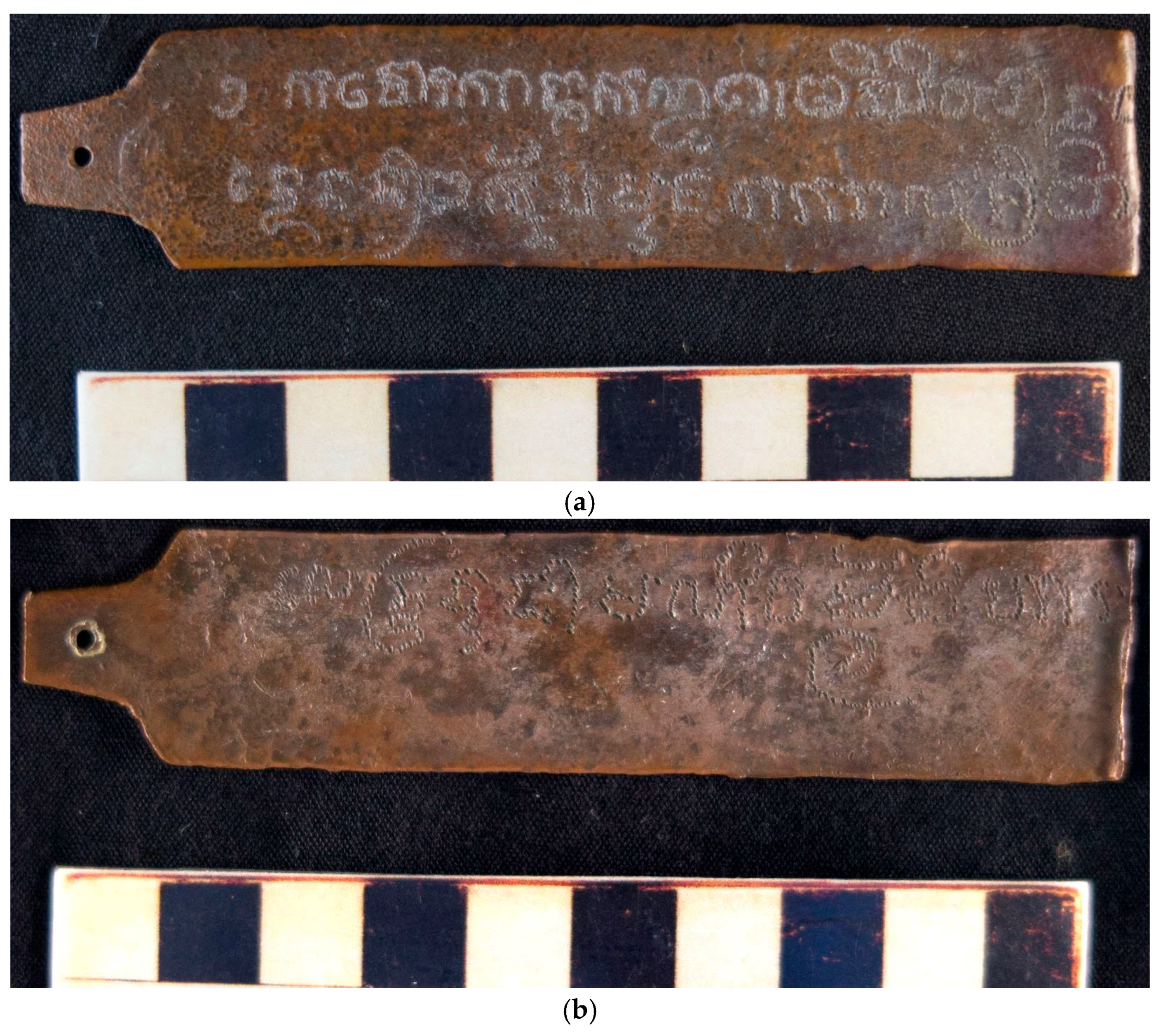
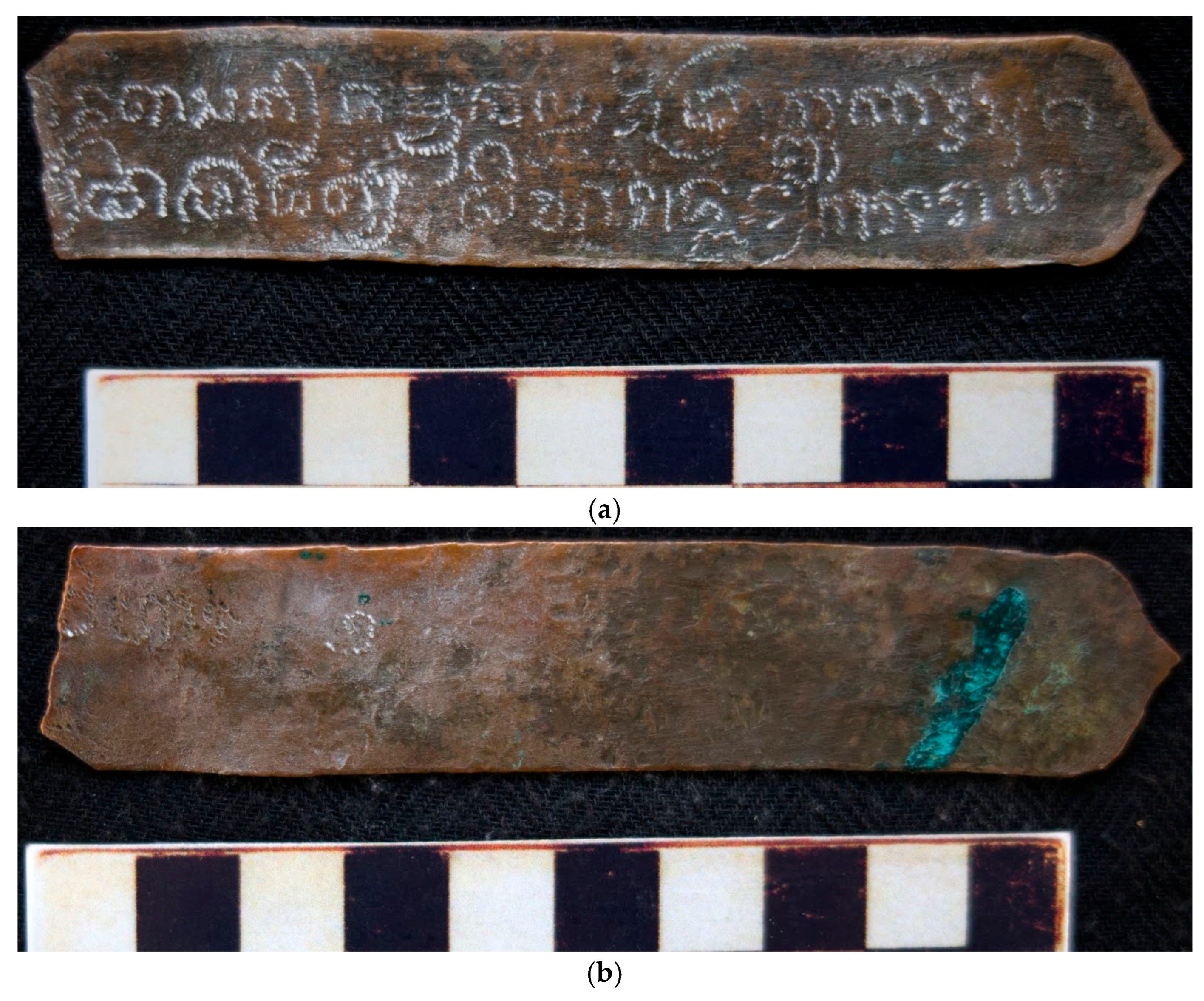
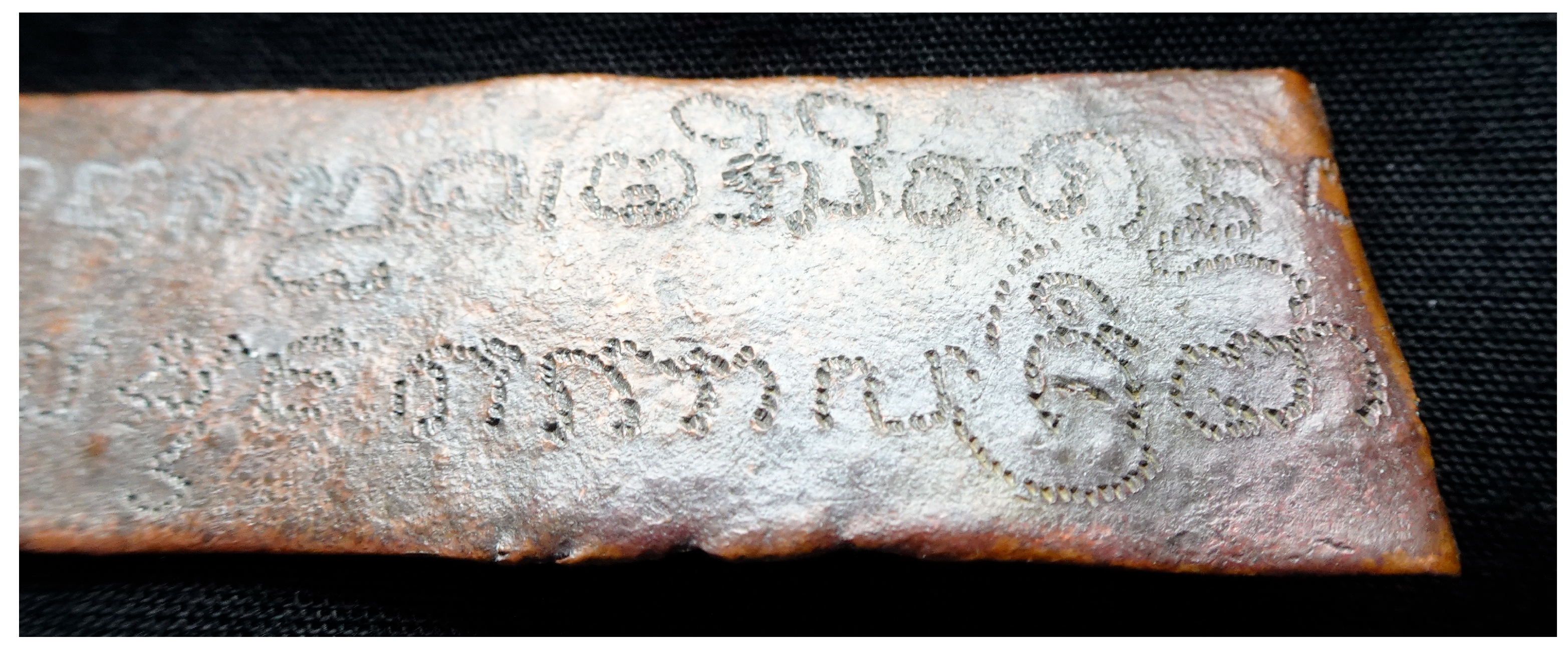

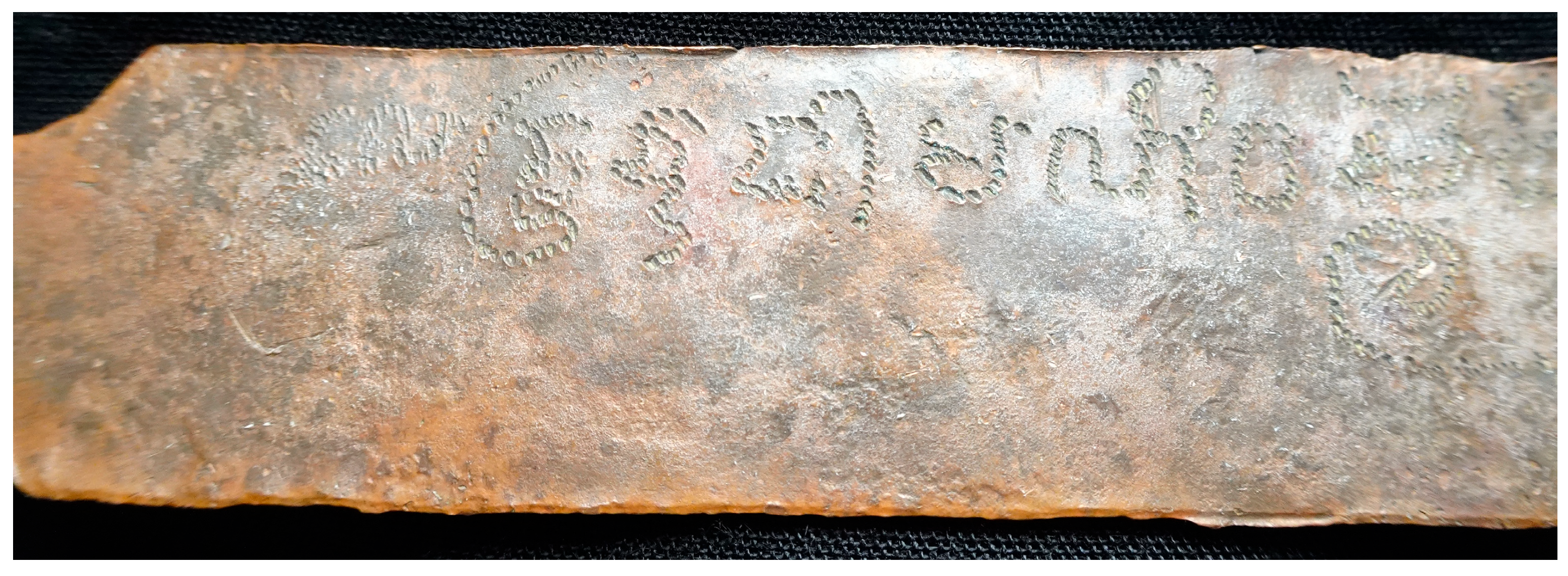

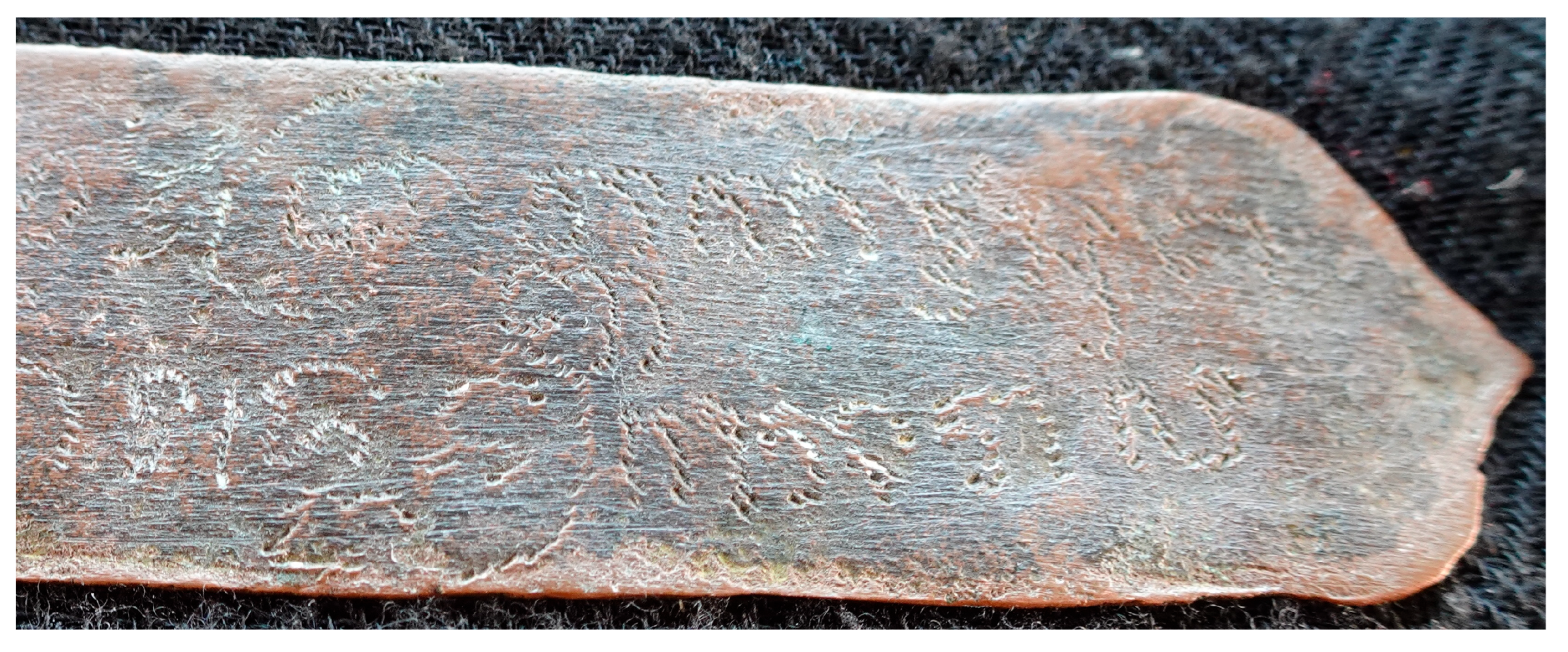
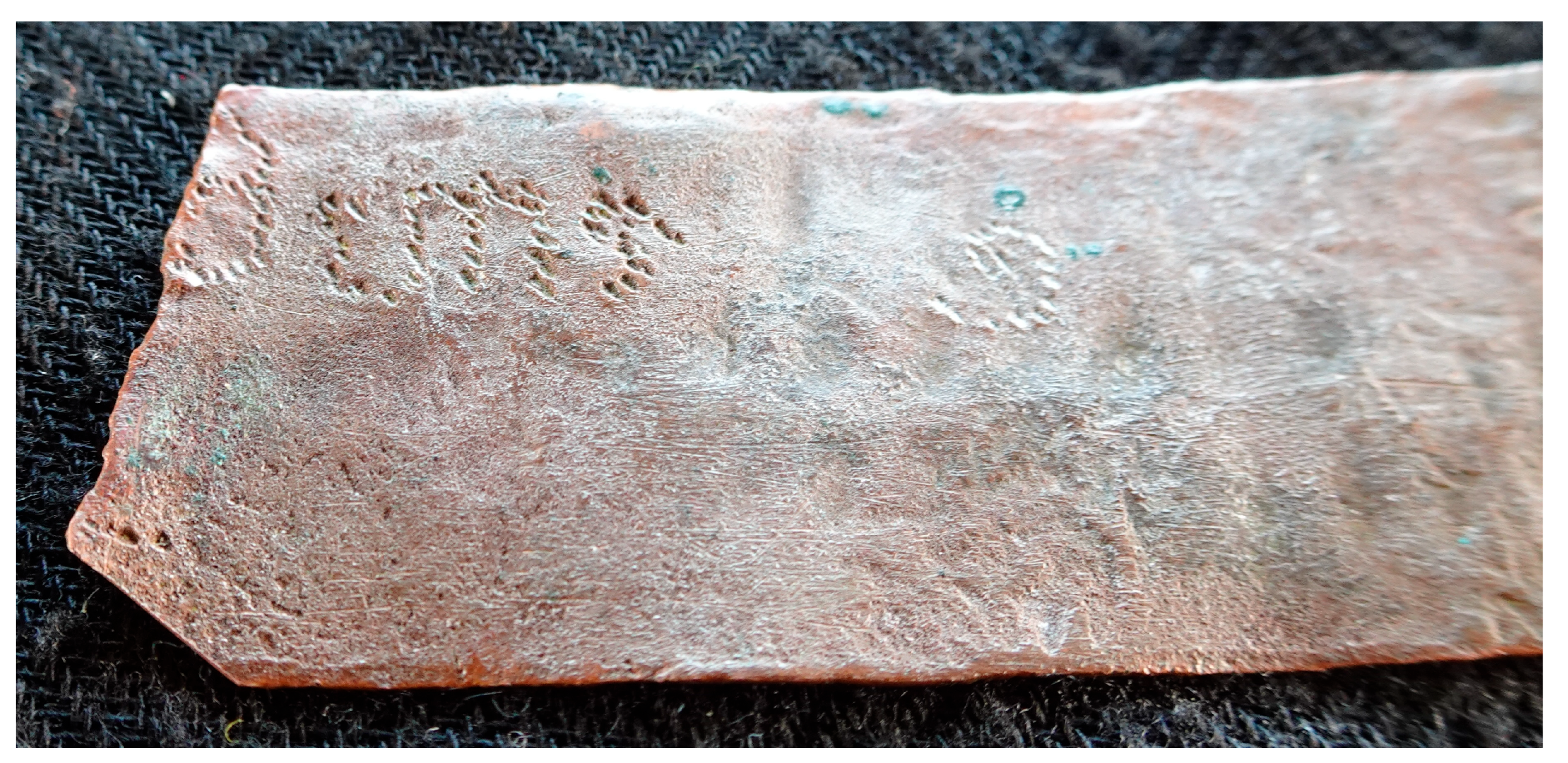

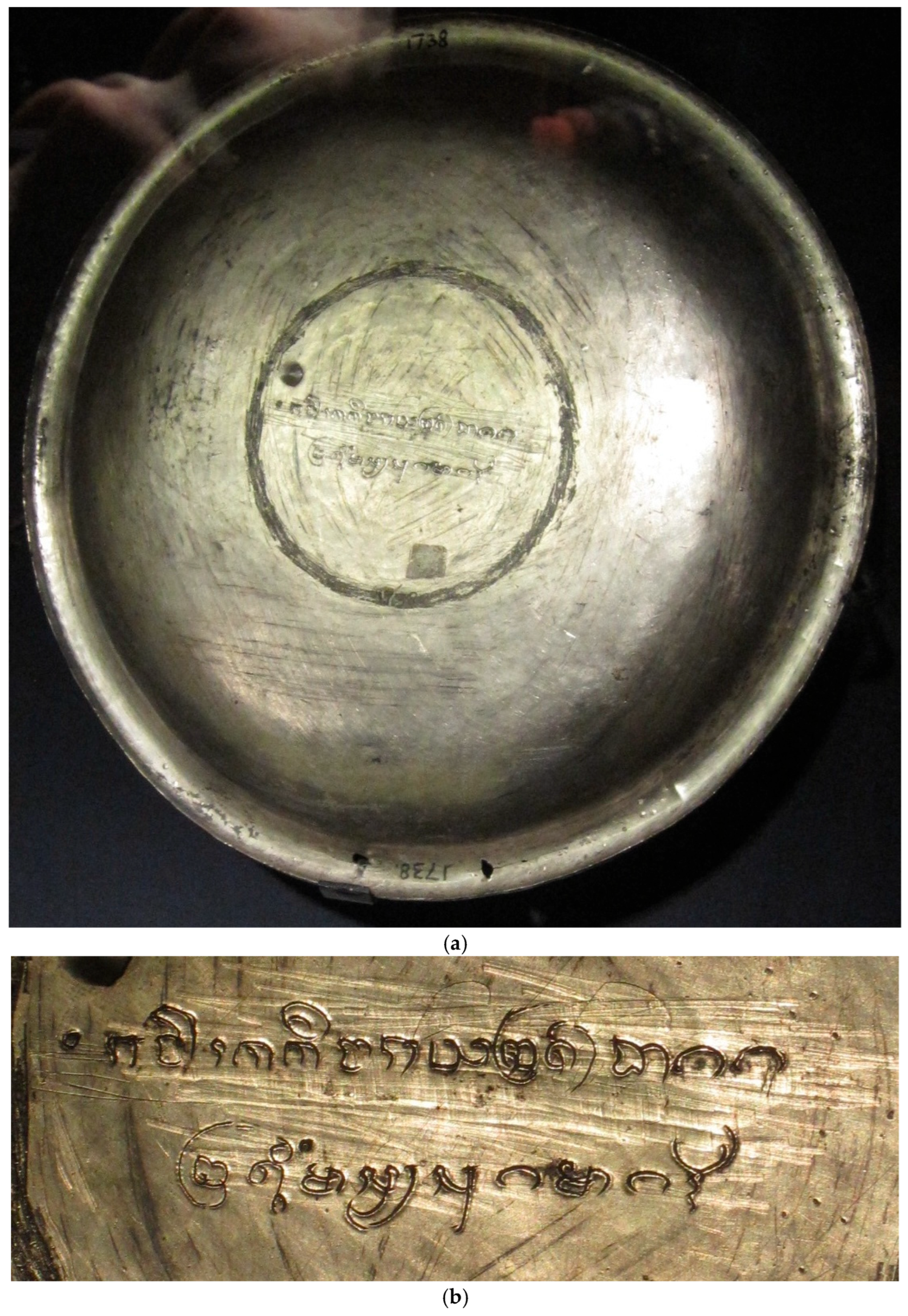
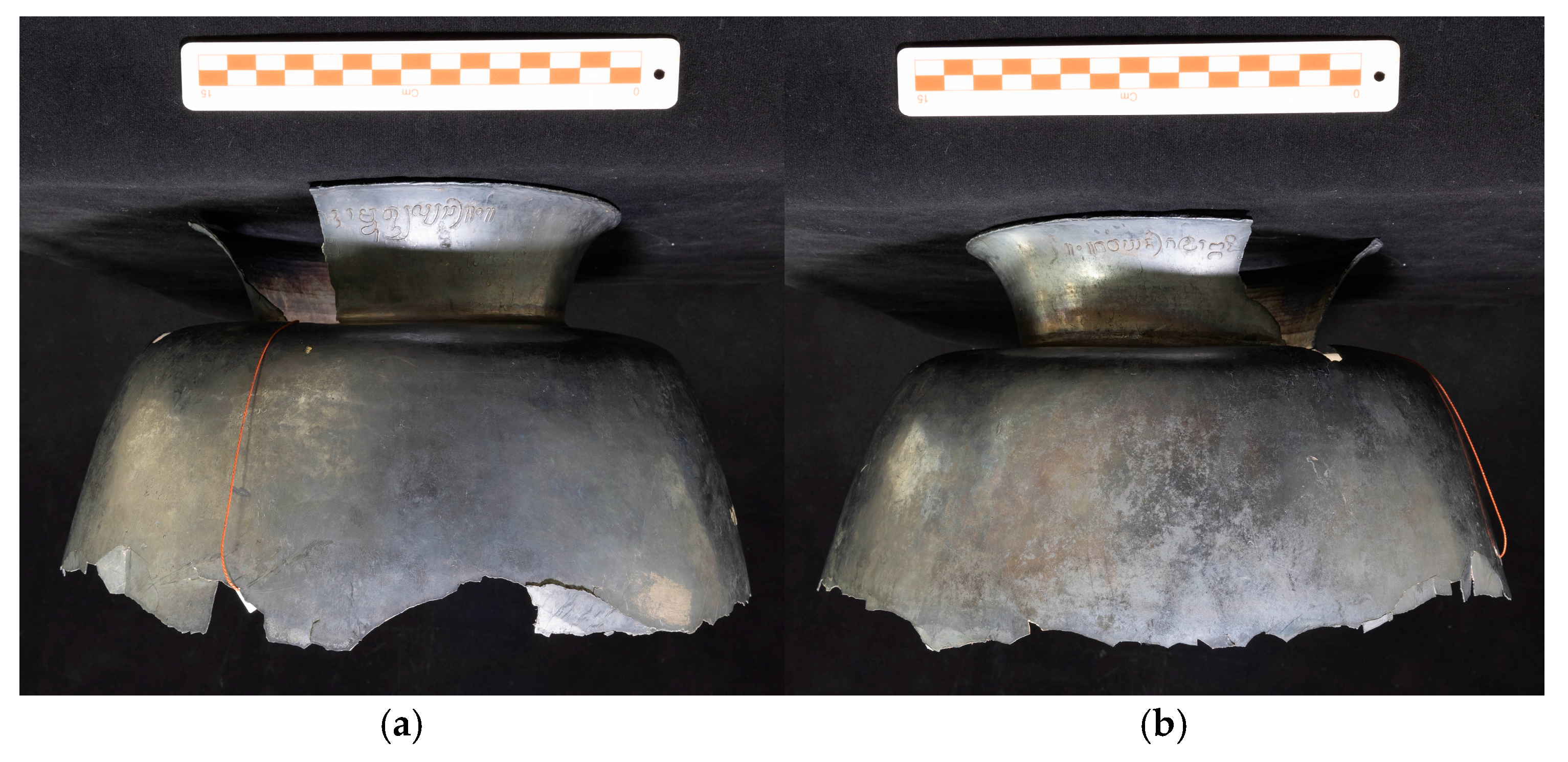
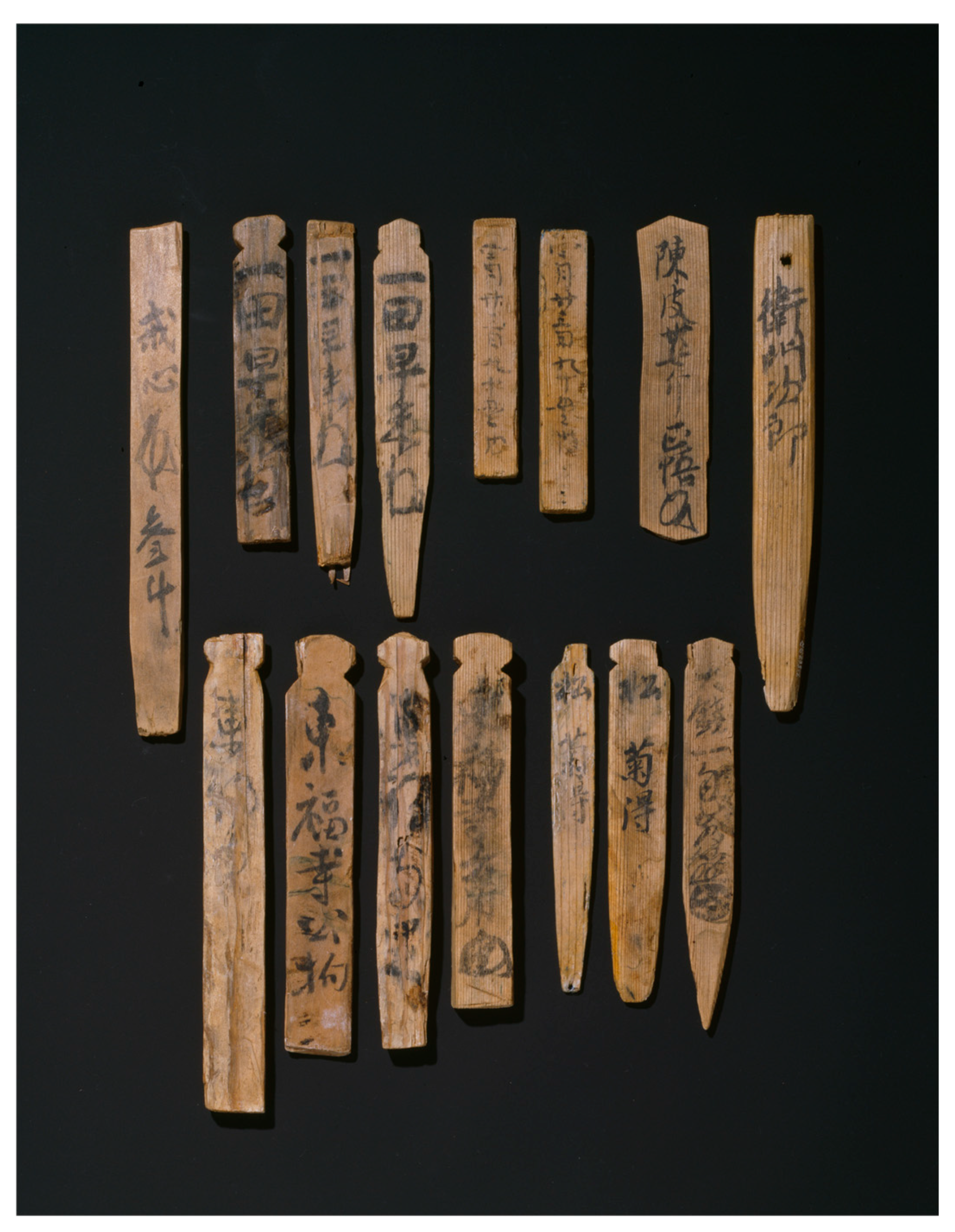
Disclaimer/Publisher’s Note: The statements, opinions and data contained in all publications are solely those of the individual author(s) and contributor(s) and not of MDPI and/or the editor(s). MDPI and/or the editor(s) disclaim responsibility for any injury to people or property resulting from any ideas, methods, instructions or products referred to in the content. |
© 2025 by the authors. Licensee MDPI, Basel, Switzerland. This article is an open access article distributed under the terms and conditions of the Creative Commons Attribution (CC BY) license (https://creativecommons.org/licenses/by/4.0/).
Share and Cite
Andhifani, W.R.; Prihatmoko, H.; Acri, A.; Griffiths, A.; Mechling, M.; Sattler, G. Maritime Links Between China, Sumatra, the Malay Peninsula, and Buddhist Monasteries in India (c. 11th–12th Centuries) in the Light of Two Fragmentary Inscribed Strips of Copper from Muara Jambi. Religions 2025, 16, 664. https://doi.org/10.3390/rel16060664
Andhifani WR, Prihatmoko H, Acri A, Griffiths A, Mechling M, Sattler G. Maritime Links Between China, Sumatra, the Malay Peninsula, and Buddhist Monasteries in India (c. 11th–12th Centuries) in the Light of Two Fragmentary Inscribed Strips of Copper from Muara Jambi. Religions. 2025; 16(6):664. https://doi.org/10.3390/rel16060664
Chicago/Turabian StyleAndhifani, Wahyu Rizky, Hedwi Prihatmoko, Andrea Acri, Arlo Griffiths, Mathilde Mechling, and Gregory Sattler. 2025. "Maritime Links Between China, Sumatra, the Malay Peninsula, and Buddhist Monasteries in India (c. 11th–12th Centuries) in the Light of Two Fragmentary Inscribed Strips of Copper from Muara Jambi" Religions 16, no. 6: 664. https://doi.org/10.3390/rel16060664
APA StyleAndhifani, W. R., Prihatmoko, H., Acri, A., Griffiths, A., Mechling, M., & Sattler, G. (2025). Maritime Links Between China, Sumatra, the Malay Peninsula, and Buddhist Monasteries in India (c. 11th–12th Centuries) in the Light of Two Fragmentary Inscribed Strips of Copper from Muara Jambi. Religions, 16(6), 664. https://doi.org/10.3390/rel16060664





